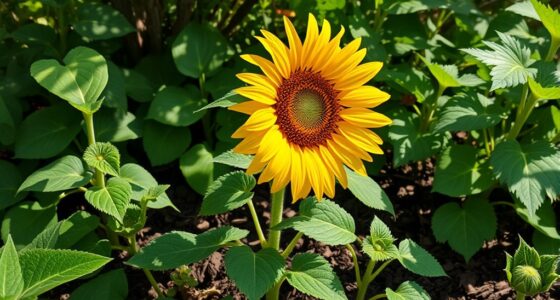Imagine stepping into your garden, where the air is filled with the delightful aroma of fresh herbs and vibrant colors dance before your eyes. Oregano, a cherished herb in countless kitchens, can elevate not just your recipes but also the health of your garden. As you cultivate your green sanctuary, consider how companion planting with oregano can create a nurturing ecosystem. The best plants to grow with oregano are more than mere neighbors; they work in harmony, enhancing each other’s growth and flavor. Join me on this journey to explore the beautiful world of oregano plant companions, where every choice can lead to a more flourishing garden!
Key Takeaways
- Oregano thrives when paired with specific companion plants.
- Companion planting can deter pests and enhance growth.
- Basil and tomatoes are excellent partners for oregano.
- Understanding plant relationships is key to a healthy garden.
- Strategic plant pairings can increase flavor and yield.
- Your garden can flourish with thoughtful companion planting.
What Is Oregano and Its Benefits?
Oregano, scientifically known as Origanum vulgare, is a popular herb in the mint family. It flourishes in well-drained soils and thrives in full sun, making it an excellent choice for gardens. This herb is widely recognized for its distinct flavor, particularly in Mediterranean cuisine. Understanding what is oregano not only enhances your culinary experience but also opens the door to its numerous health advantages.
Overview of Oregano
This aromatic herb features small, oval leaves and produces clusters of delicate flowers. Oregano is well-loved for its versatility, often used fresh or dried. The vibrant flavor it brings to dishes has made it a staple in various cultural cuisines, especially in Italian recipes. Whether used in pizza, pasta, or salads, oregano enhances the taste while boosting the meal’s nutritional profile.
Health Benefits of Oregano
Incorporating oregano into your diet offers significant health benefits. Rich in antioxidants, it helps protect your body from oxidative stress. The health benefits of oregano extend to its anti-inflammatory properties, which can alleviate various health issues. Furthermore, its antimicrobial capabilities may aid in fighting off infections, making it a valuable herb for your overall wellness.
Culinary Uses of Oregano
When it comes to culinary uses, oregano excels in diverse applications. It serves as a robust seasoning for Italian dishes, marinades, and soups. This herb pairs remarkably well with other flavors, transforming simple meals into delightful feasts. Whether fresh or dried, oregano’s distinctive taste can elevate your cooking, making it an indispensable addition to your spice cabinet.
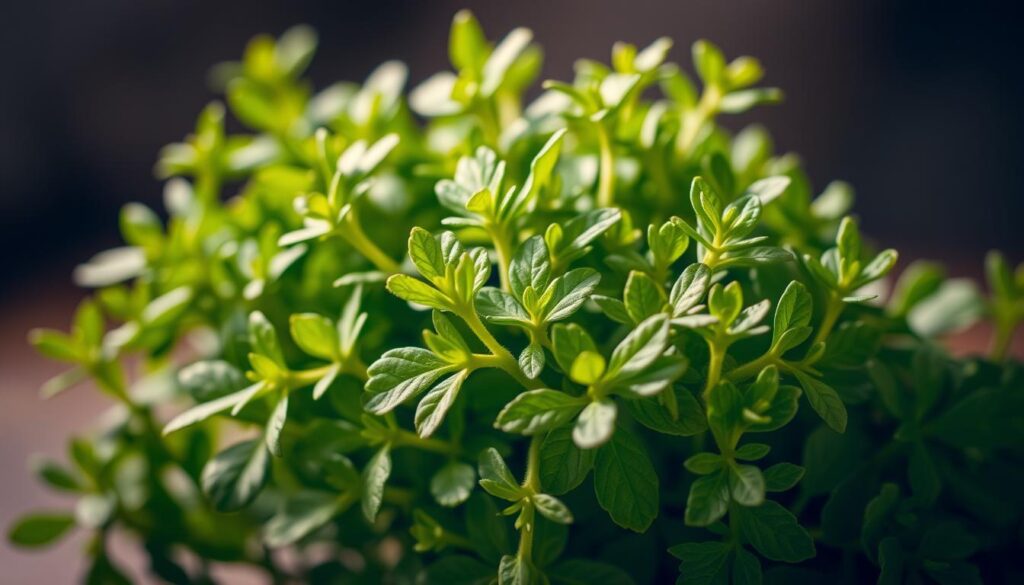
Why Companion Planting Matters
Companion planting involves strategically growing different plants alongside each other to create a thriving garden ecosystem. You may wonder why companion planting holds significance. Not only does it enhance the growth and flavor of your herbs and vegetables, but it also provides various benefits, such as pest control and improving soil health.
Enhancing Growth and Flavor
The practice of companion planting results in plants that thrive together, often leading to enhanced flavor and overall growth. Different plants can share nutrients, leading to improved taste and vigor. For example, planting oregano alongside basil can enhance both herbs’ flavors. Understanding the benefits of companion planting can guide you in arranging your garden for maximum productivity.
Pest Control Benefits
Companion plants can deter harmful pests by attracting beneficial insects that serve as natural predators. For instance, planting marigolds near your vegetables may reduce insect infestations. With proper companion planting, you will notice healthier plants and less reliance on chemical pesticides. This approach creates a more balanced garden environment and highlights the advantages of understanding why companion planting is beneficial.
Improving Soil Health
Healthy soil is the foundation for successful gardening, and companion planting plays a vital role in enhancing soil health. Certain plants fix nitrogen in the soil, while others improve soil structure, promoting nutrient availability. This contributes to a robust, fertile environment where plants can flourish. Embracing the concept of improving soil health through companion planting will lead to a more sustainable and productive garden.
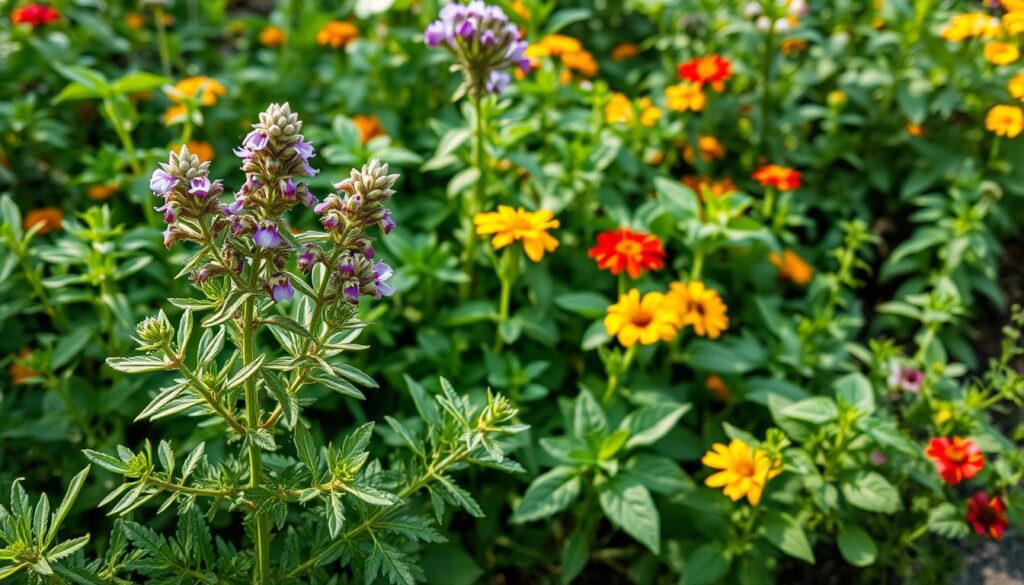
Ideal Companion Plants for Oregano
Your garden can flourish when you select the right companions for oregano. Some plants not only thrive alongside this herb but also enhance its flavor and growth. Here are several ideal plants for oregano that can benefit each other in your garden.
Basil: Perfect Pairing for Flavor
Basil serves as an excellent basil companion plant for oregano. Both herbs prefer similar growing conditions, such as warm temperatures and well-drained soil. When planted together, they can amplify each other’s aromatic qualities, making your culinary dishes even more delightful.
Tomatoes: Mutual Growth Boost
Tomatoes find harmony with oregano, benefiting from its pest-repelling properties. These two share similar watering and nutrient needs, making them perfect tomato companions. When grown together, they can create a productive and healthy garden bed.
Peppers: A Spicy Combination
If you’re looking for a spicy combination, consider pairing peppers with oregano. This duo not only thrives in similar conditions but also maximizes your garden space. With their growth complementing each other, you can enjoy an abundant harvest with minimal effort.
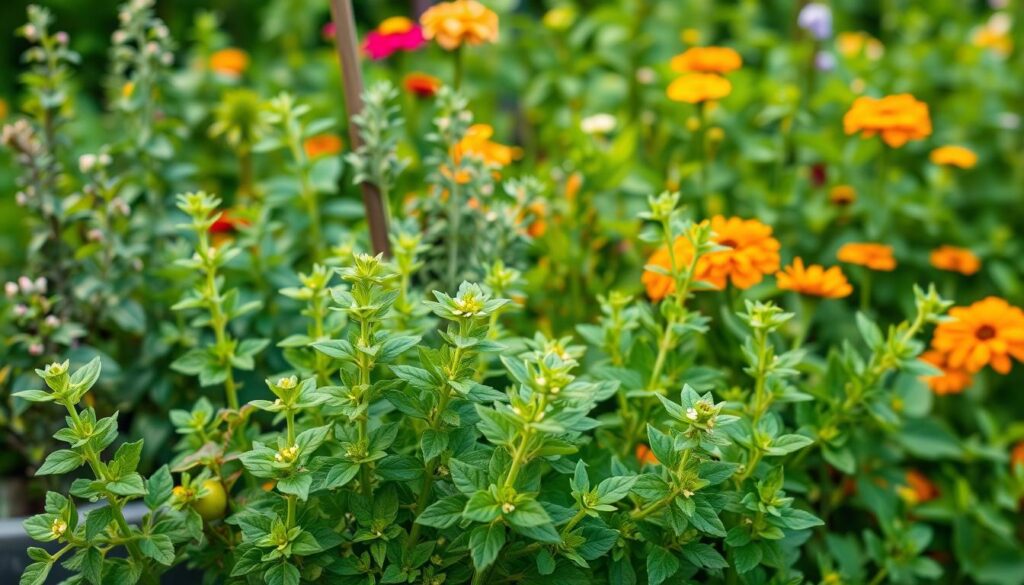
Herbs That Thrive with Oregano
Incorporating herbs that flourish alongside oregano can significantly enhance your garden’s health and productivity. The best herbs with oregano include thyme, rosemary, and sage. Each of these companions offers unique benefits, creating a harmonious environment for growth and flavor.
Thyme: A Great Herbal Match
Thyme serves as a fantastic thyme companion plant for oregano. Both herbs thrive in similar Mediterranean climates, appreciating well-draining soil and plenty of sunlight. They not only coexist well but also benefit from each other’s presence in terms of pest control and moisture retention.
Rosemary: Enhancing Aromatics
Rosemary adds a delightful aromatic quality to your herb garden while exemplifying the principles of rosemary companion planting. Its strong fragrance acts as a natural pest deterrent. This robustness makes rosemary an excellent complement to oregano, particularly in culinary dishes where their flavors can shine together.
Sage: A Complementary Herb
Sage shares similar growth requirements with oregano, blending effortlessly into the same garden space. Beyond that, sage attracts beneficial insects that can help with pollination and crop health. Planting sage alongside oregano not only enriches the flavor profiles of your dishes but also enhances the overall vitality of your herb garden.

Vegetables to Grow Alongside Oregano
Planting a variety of vegetables to plant with oregano not only enhances the efficiency of your garden but also supports healthy growth in companion plants. Consider the following options that thrive with oregano, showcasing how diversity can benefit your garden.
Carrots: Space-Saving Companions
Carrots make excellent carrot companions for oregano. They occupy various soil layers, allowing you to maximize space in your garden. This combination minimizes competition for nutrients while promoting a rich harvest. Carrots grow deep in the soil, letting oregano flourish above without hindering growth.
Cucumbers: Beneficial Growth Partners
Cucumbers can share a garden with oregano, primarily benefiting from the aromatic herb’s pest-repelling properties. While cucumbers have high-water needs, the presence of oregano helps reduce pest pressures, enabling plants to stay healthy. Just ensure you monitor watering needs for each type.
Eggplants: Thriving Together
Oregano acts as a pest deterrent for eggplants, making them ideal eggplant growth partners. These vegetables can flourish together, creating a vibrant and diverse garden. With oregano’s protective qualities, eggplants can focus energy on growth and fruit production.
| Vegetable | Companion Benefits |
|---|---|
| Carrots | Space-efficient, they share soil layers with oregano. |
| Cucumbers | Pest deterrent properties of oregano support healthy cucumber growth. |
| Eggplants | Thrives alongside oregano, benefiting from reduced pest issues. |
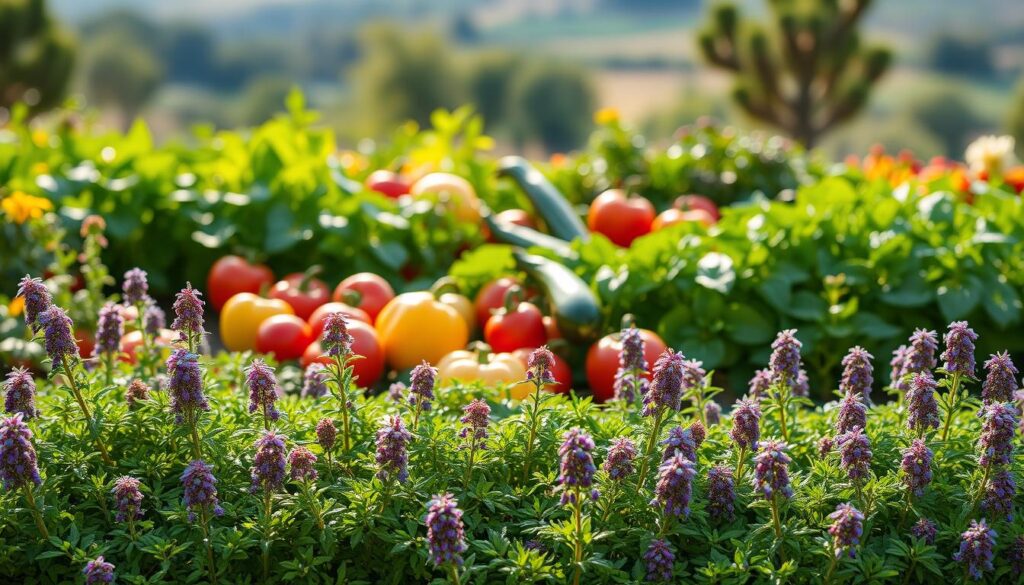
Fruits That Can Be Friends with Oregano
Choosing the right fruits to grow with oregano can lead to a thriving garden full of flavor and productivity. These partnerships not only enhance growth but also promote healthier plants. Let’s explore some excellent fruity companions for your oregano.
Strawberries: Aromatic Allies
Strawberry companions like oregano offer a fantastic alliance. The aromatic scent of oregano deters pests that often target strawberries. This natural protection allows your juicy berries to flourish, creating a bountiful harvest.
Melons: Spacing Benefits
Melons require ample space, making oregano a suitable companion. By planting them together, you ensure that both plants maintain proper airflow. Oregano’s low growth habit prevents crowding while adding an aromatic layer that benefits the overall growing environment.
Blueberries: An Underrated Pair
Don’t overlook the blueberry allies you can cultivate alongside oregano. This plant offers pest-repellent qualities that enhance blueberries’ thriving conditions. A healthy partnership leads to improved productivity and overall plant well-being.

Flowers That Attract Pollinators
Adding flowers to your garden enhances its beauty and creates a more vibrant ecosystem. Flowers with oregano boost the overall health of your garden by attracting pollinators and beneficial insects. Here are some noteworthy options to consider.
Marigolds: Natural Pest Deterrent
Marigolds serve as fantastic companions to oregano, showcasing significant marigold benefits. They deter harmful pests like aphids and whiteflies. Planting marigolds alongside your oregano can protect your herb garden while attracting helpful pollinators such as bees.
Nasturtiums: Edible Flowers
Nasturtiums are not only visually appealing but also offer edible blooms. These flowers attract beneficial insects to your garden and complement oregano’s growth. Incorporating nasturtiums provides a colorful burst while ensuring the overall health of your plants.
Sunflowers: Bright Companions
Sunflowers are perfect sunny flower partners that add a delightful touch to any garden. They attract a variety of pollinators like bees and butterflies, creating an inviting atmosphere. Planting sunflowers near your oregano enhances plant diversity, contributing to a thriving garden ecosystem.
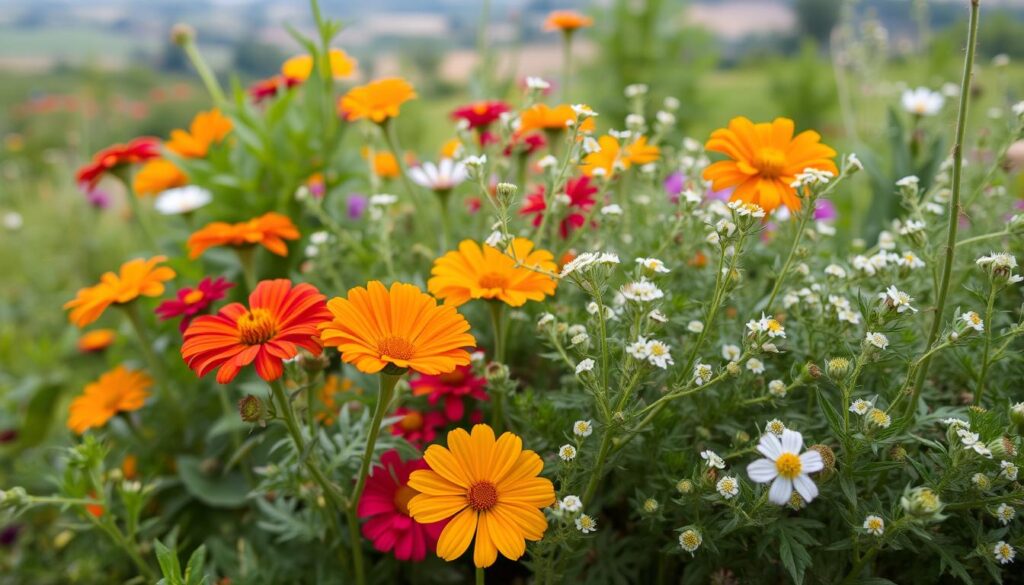
Tips for Successful Companion Planting
Creating a thriving garden involves strategic decisions regarding successful companion planting tips. Focus on planning your garden layout, ensuring that each plant has the space it needs to grow strong and healthy. An effective garden layout allows for optimal light exposure, air circulation, and accessibility for maintenance.
Planning Your Garden Layout
Start by sketching your garden layout on paper or using garden design software. Consider the height and spread of each plant to maximize sunlight and minimize shading. This approach keeps your oregano and companion plants thriving without competition.
Maintaining Proper Spacing
Maintain proper spacing between plants to promote healthy growth. For oregano specifically, aim for spacing of 18 to 24 inches apart. This spacing reduces competition for nutrients and prevents overcrowding, allowing you to cultivate a lush and productive garden.
Observing Plant Interactions
As your garden grows, take time to observe how plants interact with one another. Look for signs of competition or cooperation among your plants. By adjusting your planting arrangement based on these observations, you can enhance garden performance and achieve a harmonious growing environment.
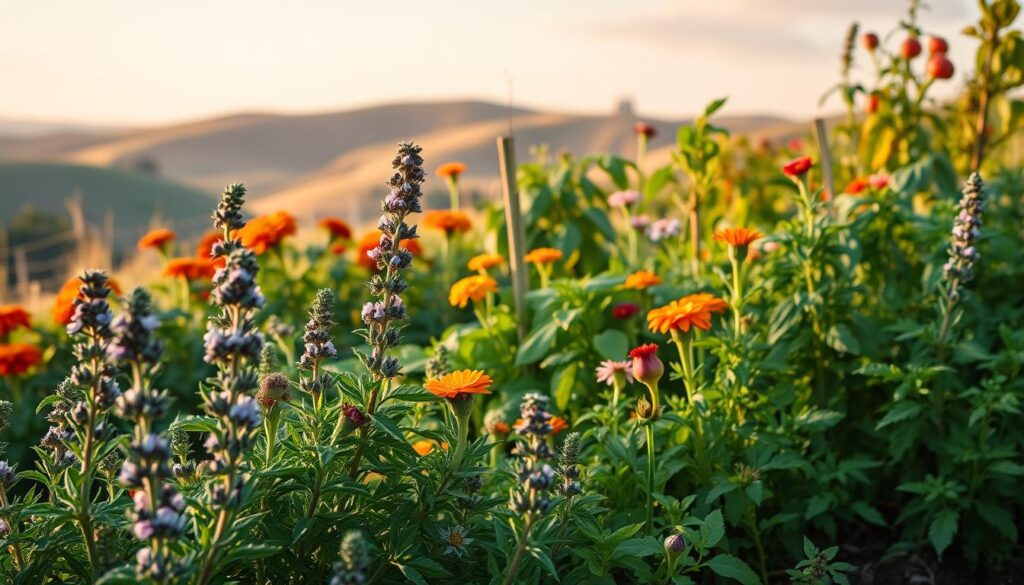
Common Mistakes in Companion Planting
Understanding common companion planting mistakes can enhance your gardening experience and productivity. Each plant in your garden has specific needs, and failing to meet them can lead to disappointing results. This section highlights several critical mistakes to avoid, focusing on overcrowding plants, light and water needs, and soil quality issues.
Overcrowding Plants
One of the most frequent errors made by gardeners is overcrowding plants. This situation can lead to intense competition for sunlight, nutrients, and water. When plants are packed too closely together, some may thrive while others suffer. Spacing plants properly allows everyone access to the essential resources they need for healthy growth.
Ignoring Light and Water Needs
Neglecting the varying light and water requirements of different species can hinder your garden’s success. Certain plants may flourish in full sun while others prefer partial shade. Watering schedules will also vary significantly. Incompatible plants alongside one another can lead to a struggle for resources, inhibiting growth. Being mindful of these factors is crucial for a harmonious garden.
Neglecting Soil Quality
Soil quality issues are another critical aspect often overlooked in companion planting. Healthy plants thrive in nutrient-rich, well-draining soil. Organic matter, such as compost, is essential for providing necessary nutrients. Conducting regular soil tests can help identify deficiencies, ensuring your plants get the right balance of nutrients to flourish.

Seasonal Considerations for Oregano
Understanding the seasonal requirements for oregano can greatly enhance its growth and flavor. This herb thrives under specific conditions, which change throughout the gardening year. You can effectively manage its care during spring planting, summer maintenance, and fall harvesting.
Spring Planting: Best Practices
Spring marks the perfect time for planting oregano. The warming soil provides an ideal environment for growth. Follow these spring planting tips:
- Choose a sunny location, as oregano requires plenty of sunlight.
- Prepare the soil by ensuring it is well-draining, as this herb does not thrive in overly moist conditions.
- Space your seeds or plants adequately to promote airflow and prevent disease.
Summer Care for Oregano
As summer progresses, your focus shifts to maintaining the health of your oregano. Pay attention to seasonal oregano care by properly managing watering needs. Key tips include:
- Water deeply but infrequently to encourage root growth.
- Be vigilant against pests that might take advantage of the warm weather.
- Prune lightly to maintain shape and promote bushier growth.
Fall Harvesting Tips
Fall is the time for harvesting your fragrant oregano. For the best flavor, gather your herbs just before they flower. Here are some effective fall harvesting strategies:
- Harvest in the morning after the dew has dried but before the heat of the day.
- Cut stems close to the base while ensuring you leave some leaves for potential regrowth.
- Store your freshly cut oregano in a cool, dark place to maintain its potency.

Pests to Watch Out For with Oregano
When cultivating oregano, it is essential to keep an eye on various pests that may threaten its health. Common pests with oregano include aphids, spider mites, and whiteflies, which can cause significant damage if not managed promptly. Understanding the signs of these pests and implementing effective strategies for their control will help you maintain a thriving oregano crop.
Aphids: Prevention Strategies
Aphids can be troublesome for oregano plants, often clustering on young shoots and leaves. To prevent these pests, focus on attracting beneficial insects like ladybugs, which naturally prey on aphids. Regular inspections can help catch aphid populations early. If aphids are found, consider using gentle methods such as insecticidal soap or neem oil for effective aphid prevention.
Spider Mites: Identifying Issues
Spider mites are tiny but can cause damage by feeding on plant sap, leading to leaf discoloration and stunted growth. Look for fine webbing on the underside of leaves as a telltale sign of spider mite activity. For spider mite control, regularly misting your plants or using horticultural oils can create an unfavorable environment for these pests. Staying vigilant is key to addressing spider mite issues before they escalate.
Whiteflies: Control Methods
Whiteflies are another pest that can negatively impact the vitality of oregano. They tend to congregate on the undersides of leaves, sucking sap and disrupting plant health. To combat whiteflies, utilize yellow sticky traps to monitor their presence. Strong blasts of water can dislodge them. Consider introducing natural predators like parasitic wasps, which can significantly contribute to whitefly control.

How to Care for Companion Plants
Caring for companion plants effectively enhances both their growth and overall garden health. By employing appropriate watering techniques, using correct fertilizing tips, and implementing regular pruning, you can cultivate a thriving ecosystem within your garden.
Watering Techniques
Establishing efficient watering techniques is essential for the health of your companion plants. These plants often have varying moisture needs, so group them by their water requirements. Utilize techniques such as:
- Drip irrigation for targeted moisture delivery
- Mulching to retain soil moisture and prevent evaporation
- Watering early in the morning to minimize evaporation and allow foliage to dry
Fertilizing Guidelines
Incorporating fertilizing tips into your routine can set the stage for robust plant growth. Choose balanced, slow-release fertilizers at the beginning of the growing season. Consider the unique nutrient needs of each companion plant, applying fertilizers as follows:
| Plant Type | Fertilizing Frequency | Nutrients Needed |
|---|---|---|
| Herbs | Every 6-8 weeks | Nitrogen and Phosphorus |
| Vegetables | Once a month | Potassium and Micronutrients |
| Flowers | Twice per growing season | General purpose |
Pruning for Better Growth
Regular pruning can stimulate stronger growth and improve air circulation among your plants. This practice helps prevent disease while supporting a healthy garden ecosystem. Focus on:
- Removing dead or yellowing leaves to promote new growth
- Trimming back overgrown stems to encourage bushier plants
- Monitoring plant health and adjusting pruning accordingly

Harvesting Oregano and Its Companions
Understanding the best practices for harvesting oregano enhances the flavor and usefulness of your herb garden. Knowing when and how to harvest helps you get the most out of your plants while encouraging further growth. Let’s explore effective methods for timing, harvesting techniques, and storing oregano tips.
Timing Your Harvest
The ideal time for harvesting oregano is in the morning after the dew has dried. This timing ensures that the essential oils, responsible for the herb’s rich flavor, are at their peak. Opt for the later part of spring through early summer for the best results, as this is when the plant’s growth is robust.
Techniques for Maximum Flavor
Utilizing proper harvesting techniques enhances the quality of oregano. Cut the stems just above a set of leaves. This method not only provides you with fresh herbs but encourages the plant to produce new growth. Use sharp scissors or shears to make clean cuts, reducing the risk of damaging the plant.
Storing Fresh Oregano
Once you have harvested oregano, consider these storing oregano tips to maintain its flavor and quality. You can store fresh oregano in a cool, dark place. For longer-term storage, drying the leaves is an excellent option. Place the leaves in a paper bag or use a dehydrator, ensuring that they keep their aromatic properties and health benefits.

Creating a Companion Planting Guide
Designing an effective companion planting guide is essential for optimizing your garden’s potential. This guide allows you to monitor the interactions between various plants and how they affect each other’s growth. Through growth documentation, you can analyze the performance of your plants and adapt your strategies accordingly.
Documenting Growth Patterns
Careful documentation of growth patterns helps you identify which combinations flourish and which may need adjusting. By keeping detailed notes, you’ll be able to understand the unique requirements of each plant. This practice forms the foundation of creating planting guides that ensure successful growing conditions in the future.
Adjusting for Future Planting
As seasons change, so do the necessities of your plants. Revising your planting guide based on your observations can lead to improved results. This adjustment helps you cultivate an even more productive garden, making every planting season more fulfilling and effective.
Sharing Your Experience
Engaging with fellow gardeners and sharing gardening experiences can enrich your own understanding of companion planting. Exchange tips and successes with others, fostering a community of learning. Your insights might help someone else create their own thriving garden while you gather new ideas for yours.

Conclusion: Embrace Oregano in Your Garden
Embracing oregano as a centerpiece in your garden can significantly enhance your gardening experience. As you reflect on your companion choices, think about the unique pairs that thrive together, allowing your plants to support one another in growth and health. By thoughtfully selecting companions for oregano, you create a harmonious environment that not only meets your gardening goals but also caters to the tastes of your culinary adventures.
As you nurture the vegetables, fruits, and herbs alongside oregano, you will find yourself enjoying your garden even more. The tangible rewards of your efforts—vibrant colors, delightful aromas, and bountiful flavors—are the essence of home gardening. Your oregano plants will flourish alongside their companions, creating an ecosystem that brings beauty and productivity to your outdoor space.
Ultimately, embracing oregano in your garden means engaging in a rewarding journey where every plant contributes to the overall success of your garden. The joy of seeing healthy plants and tasting freshly harvested herbs adds fulfillment to your gardening endeavors. With careful planning and a bit of love, you can create a thriving landscape that reflects your passion for gardening.



